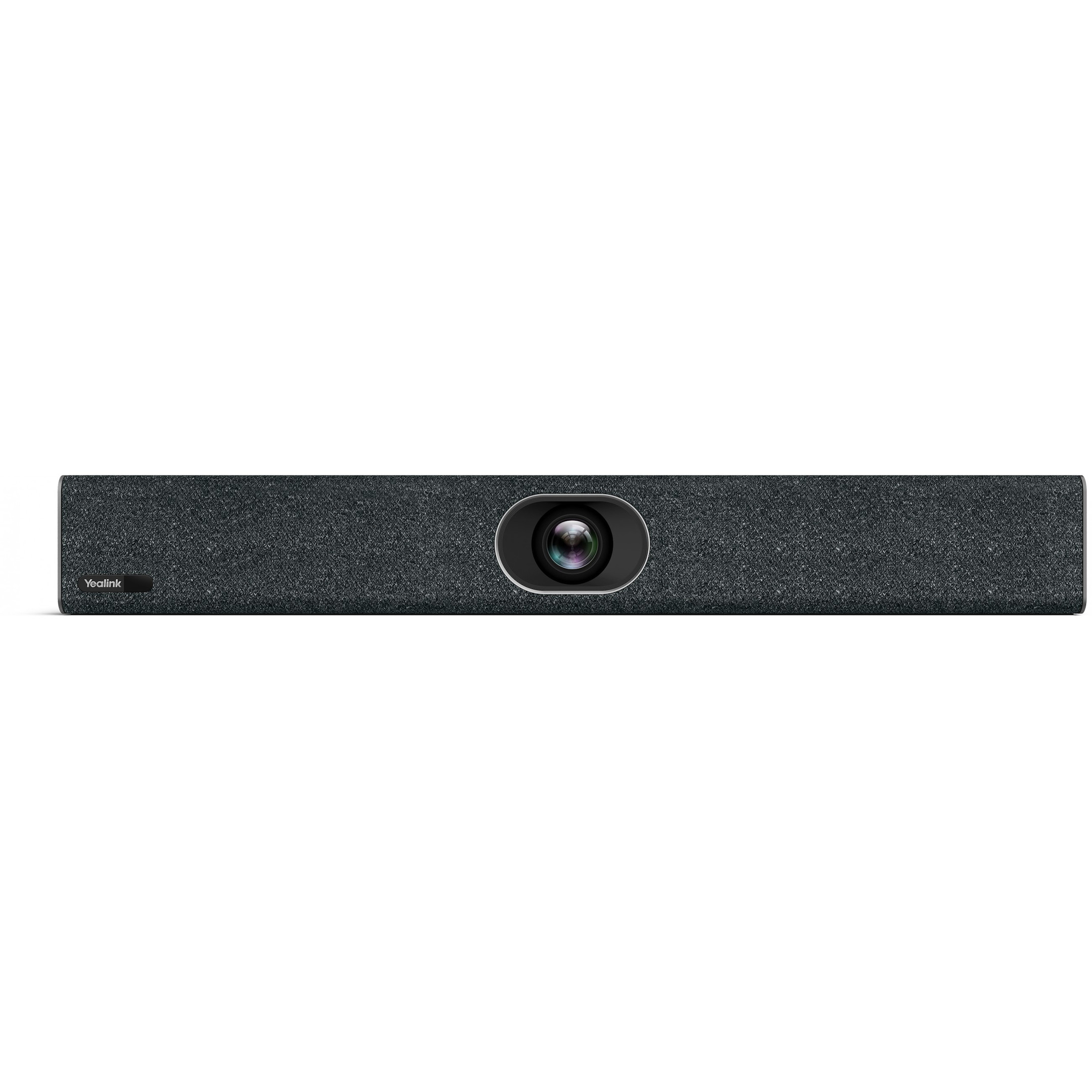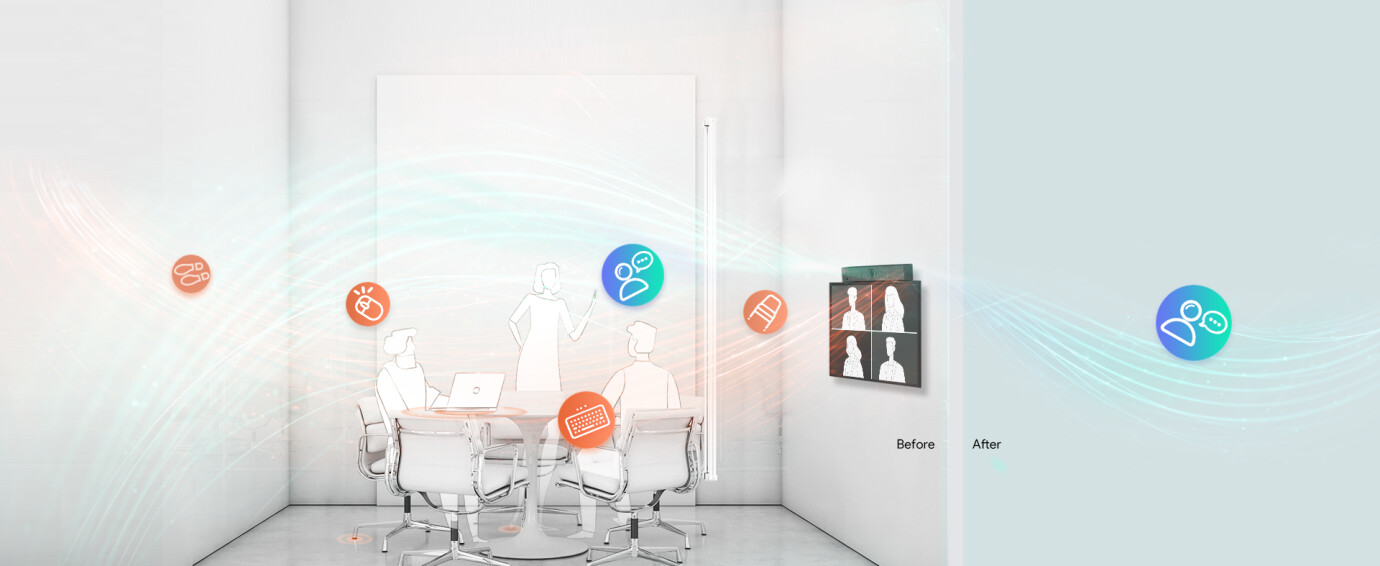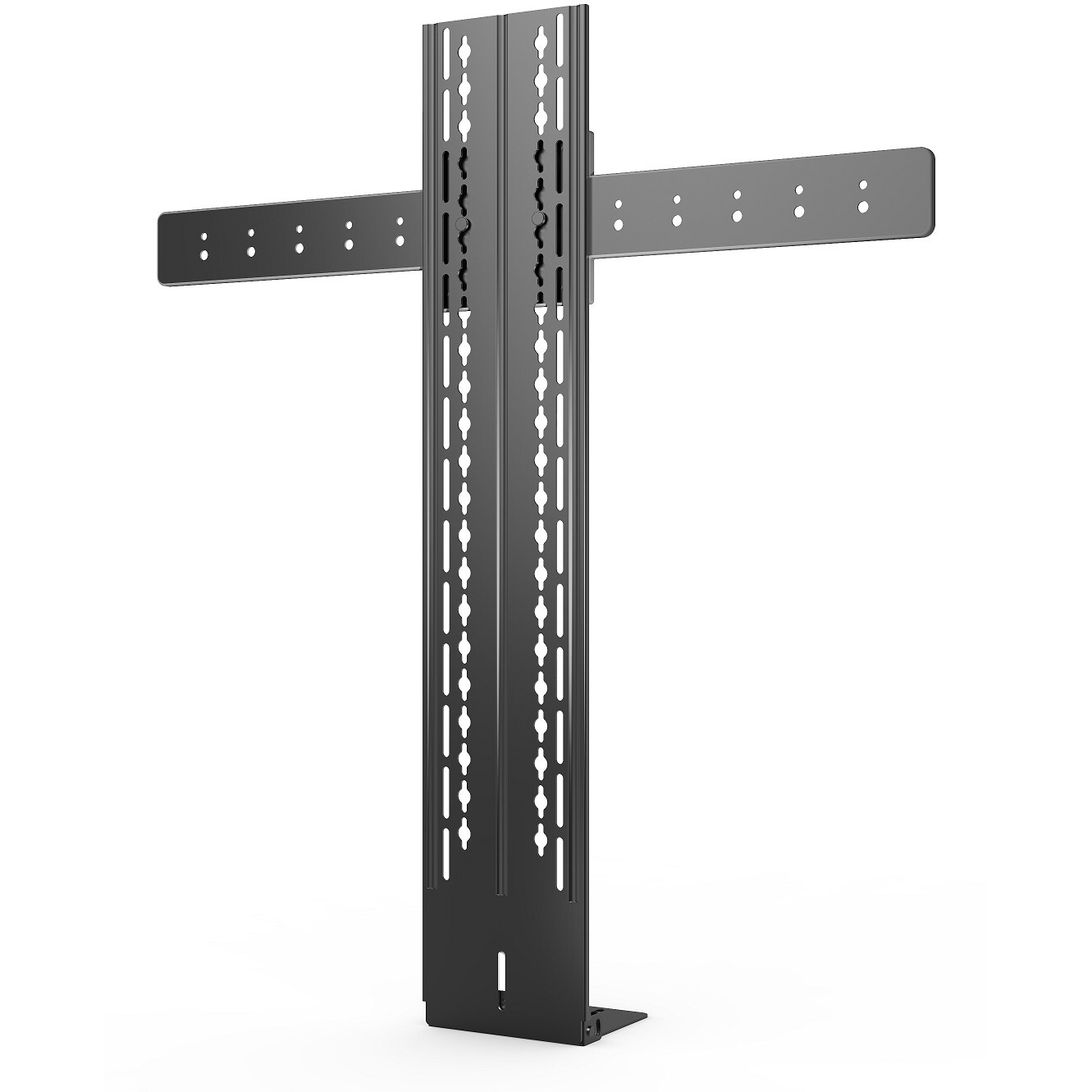























£1,295.01*


Frequently purchased together
Product information
The A20 is an all-in-one collaboration bar for Microsoft Teams and Zoom. It is ideal for small to medium-sized conference rooms. It has a 133° FoV 20MP AI camera and Ultra HD Voice and Microphone. Features such as Plug &Play, Auto Framing and Speaker Tracking round out the user experience.
Highlights:
- 133° FoV
- 20MP AI Camera
- Ultra HD Voice and Microphone
- Plug &Play
- Auto Framing
- Speaker Tracking
Achieve more
The Meeting Bar A20 is designed for small rooms. It features a 20-megapixel sensor and a 120° field of view, ensuring an ultra-clear and ultra-wide view even in small rooms.
AI-assisted viewing modes
Auto-framing
Auto-framing detects the number and positions of participants and frames all participants in the most appropriate view, even in small rooms.

Speaker tracking
Speaker tracking frames the speaker in real time, creating a lively face-to-face meeting experience and keeping participants engaged.
PIP - Picture-in-Picture mode
Picture-in-Picture tracks the speaker and frames them in their own window, separated from the other windows to provide an all-round view, so users can keep an eye on the speaker even if they are sitting far away in a medium-sized room.
Multi-Focus Framing
The Multi-Focus Framing mode not only detects and frames each participant, but also turns identical windows of multiple people into a recombined meeting view, solving the problem of distraction caused by an unclear background.
INCREDIBLE VOICE IN EVERY CORNER
The 8 MEMS microphone arrays and speakers built into the Yealink Meeting Bar fully cover a medium-sized room up to 6 meters in length. Since the Meeting Bar is equipped with a powerful independent audio processing unit, you can enjoy a worry-free full-duplex voice experience with superior performance.

KI-BASED VOICE - CLEARS ALL NOISE
Yealink's enhanced AI noise reduction makes the audio experience even more brilliant. Using an extensive deep-learning sound database to reduce background noise, it's more about intelligent audio analysis than standard audio frequency filtering. Distracting keyboard chatter, mouse clicks, footsteps and other ambient noises are intelligently suppressed so that the user can enjoy crystal clear audio quality.
Technical data
| Name | Yealink A20-010 Conference Camera, 20 MP, 30 fps, 133° |
|---|---|
| Article number | 1000027270 |
| GTIN/EAN | 6938818314979 |
| Manufacturer SKU | 1206650 |
| Model name | A20-010 |
| Brand | Yealink |
| Product Type | Conference Camera |
| Frames per Second | 30 fps |
| Camera resolution | 20 MP |
| Field of view | 133° |
| Inputs | 1x Ethernet , 2x USB-A Inputs HDMI: Digital connection for the transmission of picture & sound. Necessary for high-resolution picture quality (HDTV). Since HDMI 1.4 (High Speed) suitable for transmission of 3D content in Full HD. For high-resolution picture quality in UHD, 4K or HDR, the connection via HDMI 2.0a and higher is suitable. HDMI 2.1 or higher should be used from 120Hz refresh rate in 4K. VGA: The VGA connector is a 15-pin connector for analogue image transmission. It is also called DSub15 and is often found on notebooks and PCs. Compared to the other analogue connections, it offers good picture quality. It can be screwed to the input or output device and can be adapted to YUV with a suitable configuration. DisplayPort: The DisplayPort connection is a VESA-standardised connection for the transmission of image and sound data. In addition to HDCP encryption, DPCP is also supported. Due to its compact size, the connection is most commonly used in notebooks. An extra small variant is the MiniDisplayPort, which is used especially with Apple devices. DVI: DVI (Digital Visual Interface) is an interface for the transmission of video data. Only analogue signals can be transmitted via DVi-A, only digital signals via DVI-D and both types of signals via DVI-I. USB: USB (Universal Serial Bus) is used to control and manage the projector (USB-B). With some business devices, office files and images can also be presented directly with a USB stick or a mouse can be connected via the USB input (USB-A). Toslink: The Toslink connection is an optical signal connection that works on an optical fibre basis. It is used for the digital transmission of audio signals. The optical design offers a lower susceptibility to interference from external magnetic and electrical influences. The connection is mostly used in the area of DVD / Blu-ray players and comparable devices in connection with an AV receiver, if these work with dts or Dolby Digital signals. YUV: The YUV connection, also called Y Cb/Pb Cr/Pr or component connection, is an analogue video connection with three channels (light intensity and two colour channels). Qualitatively, it is the best analogue video connection. Component cable: The YUV connector transmits analogue signals over three cables (Y=black and white UV=colours). YUV is used to transmit HDTV and is compatible with Cinch, for example. S-Video: The S-Video connection is also called S-VHS or Hosiden connection. Compared to the Cinch video connection, it works with two channels (brightness/colour). In terms of quality, it is somewhat better than the Cinch video connection, but there are also limitations. These can be explained by the susceptibility of the signal, which is reflected in picture distortions, for example. Cinch: The cinch video connection is also called composite connection. To make it easier to recognise, it is usually sheathed in yellow. Since the transmission is only via one channel, the picture quality is on a low level. D-Sub15: The VGA connector is a 15-pin connector for image transmission on an analogue basis. It is also called DSub15 and is often found on notebooks and PCs. Compared to the other analogue connectors, it offers good picture quality. It can be screwed to the input or output device and can be adapted to YUV with a suitable configuration. RS232: The RS232 interface can be used to control or manage the projector. Mini Jack: With a single-pin Mini Jack, mono audio signals can be transmitted, with a two-pin stereo audio signals and with a three-pin stereo audio signals and image data can be transmitted. Scart: Scart is a connector that can be used to transmit analogue audio and video signals. It is compatible with other analogue connections such as RCA or S-Video. ARC: The audio return channel, also called ARC or audio return channel, was introduced with HDMI version 1.4 to reduce the amount of cabling between HDMI components. The audio return channel runs via the existing HDMI cable. Therefore, an additional cable for the sound no longer needs to be connected. However, both devices must support ARC. All audio file formats that are also transmitted via the SPDIF interface can be transmitted via the audio return channel. These include Dolby Digital, Digital Theatre Sound and PCM audio. As an example, a connection between a TV (including receiver) and an AV receiver could be made via an HDMI cable. The sound from the TV is fed back via the HDMI cable. Previously, an additional digital cable (coaxial or Tos-Link) was required for the audio signals. |
| Outputs | 2x HDMI Outputs HDMI: Digital connection for the transmission of picture & sound. Necessary for high-resolution picture quality (HDTV). Since HDMI 1.4 (High Speed) suitable for transmission of 3D content in Full HD. For high-resolution picture quality in UHD, 4K or HDR, the connection via HDMI 2.0a and higher is suitable. HDMI 2.1 or higher should be used from 120Hz refresh rate in 4K. VGA: The VGA connector is a 15-pin connector for analogue image transmission. It is also called DSub15 and is often found on notebooks and PCs. Compared to the other analogue connections, it offers good picture quality. It can be screwed to the input or output device and can be adapted to YUV with a suitable configuration. DisplayPort: The DisplayPort connection is a VESA-standardised connection for the transmission of image and sound data. In addition to HDCP encryption, DPCP is also supported. Due to its compact size, the connection is most commonly used in notebooks. An extra small variant is the MiniDisplayPort, which is used especially with Apple devices. DVI: DVI (Digital Visual Interface) is an interface for the transmission of video data. Only analogue signals can be transmitted via DVi-A, only digital signals via DVI-D and both types of signals via DVI-I. USB: USB (Universal Serial Bus) is used to control and manage the projector (USB-B). With some business devices, office files and images can also be presented directly with a USB stick or a mouse can be connected via the USB input (USB-A). Toslink: The Toslink connection is an optical signal connection that works on an optical fibre basis. It is used for the digital transmission of audio signals. The optical design offers a lower susceptibility to interference from external magnetic and electrical influences. The connection is mostly used in the area of DVD / Blu-ray players and comparable devices in connection with an AV receiver, if these work with dts or Dolby Digital signals. YUV: The YUV connection, also called Y Cb/Pb Cr/Pr or component connection, is an analogue video connection with three channels (light intensity and two colour channels). Qualitatively, it is the best analogue video connection. Component cable: The YUV connector transmits analogue signals over three cables (Y=black and white UV=colours). YUV is used to transmit HDTV and is compatible with Cinch, for example. S-Video: The S-Video connection is also called S-VHS or Hosiden connection. Compared to the Cinch video connection, it works with two channels (brightness/colour). In terms of quality, it is somewhat better than the Cinch video connection, but there are also limitations. These can be explained by the susceptibility of the signal, which is reflected in picture distortions, for example. Cinch: The cinch video connection is also called composite connection. To make it easier to recognise, it is usually sheathed in yellow. Since the transmission is only via one channel, the picture quality is on a low level. D-Sub15: The VGA connector is a 15-pin connector for image transmission on an analogue basis. It is also called DSub15 and is often found on notebooks and PCs. Compared to the other analogue connectors, it offers good picture quality. It can be screwed to the input or output device and can be adapted to YUV with a suitable configuration. RS232: The RS232 interface can be used to control or manage the projector. Mini Jack: With a single-pin Mini Jack, mono audio signals can be transmitted, with a two-pin stereo audio signals and with a three-pin stereo audio signals and image data can be transmitted. Scart: Scart is a connector that can be used to transmit analogue audio and video signals. It is compatible with other analogue connections such as RCA or S-Video. ARC: The audio return channel, also called ARC or audio return channel, was introduced with HDMI version 1.4 to reduce the amount of cabling between HDMI components. The audio return channel runs via the existing HDMI cable. Therefore, an additional cable for the sound no longer needs to be connected. However, both devices must support ARC. All audio file formats that are also transmitted via the SPDIF interface can be transmitted via the audio return channel. These include Dolby Digital, Digital Theatre Sound and PCM audio. As an example, a connection between a TV (including receiver) and an AV receiver could be made via an HDMI cable. The sound from the TV is fed back via the HDMI cable. Previously, an additional digital cable (coaxial or Tos-Link) was required for the audio signals. |
| wireless technology | Bluetooth wireless technology WLAN: WLAN (Wireless Local Area Network) refers to a wireless network. For example, projectors or displays can be connected wirelessly to various sources (notebooks, smartphones, etc.) to realise wireless image transmission. In some cases, additional components (dongles/adapters) are required for this if a wireless connection is not directly supported. AirPlay: Apple's AirPlay technology is used for wireless transmission of content, such as music and videos, from iOS and Mac devices. These can also be receiver devices such as speakers, AV receivers and stereo systems or TVs. Streaming also works from an iOS device to a matching receiver. The protocol developed by Apple can also be licensed by other manufacturers. iProjection: With the free Epson iProjection app, projectors can be operated remotely and office content and photos can be projected. The app is compatible with current Epson business projectors and can also be used as a practical remote control. Other features of this functionality include searching for available projectors, volume control, mute, and a freeze function to freeze the current image of a presentation. The most important Office contents, such as Word, Excel, PowerPoint, Keynote and PDF files, are supported and can be played back directly from the medium. Images in JPEG and PNG format can also be presented directly. The Epson iProjection app is available for download free of charge from the Apple App Store and the google Play Store. Easy MP: A special network function from Epson. The Easy MP function allows you to present efficiently over multiple computers via an existing network. Easy MP allows you to transfer a presentation, images as well as audio data via the network and thus receive a selection from various sources in the network. |
| Features | Microsoft Teams , Speaker Tracking |
| Product width | 60 cm |
| Product height | 8.2 cm |
| Product depth | 6.8 cm |
| Weight | 1 kg |
| Colour | Grey |
| Delivery contents | HDMI Cable , Power cable |
| Condition | New |
| Warranty | 24 Month |
| Warranty type | Bringin service Service and support information |
Manufacturer's warranty information:
Here you will find more detailed information on the different types of warranty. Please refer to our manufacturer overview for contact details and warranty conditions for the corresponding warranty claim. Statutory warranty rights are not restricted by an additional manufacturer's warranty. Our liability for defects is governed by law. Defect rights can be claimed free of charge.
Downloads
Product safety
| Person responsible for the EU |
|---|
| ALSO Deutschland GmbH |
| Ernst-Heinkel-Str. 4 |
| 94315 Straubing |
| Germany |
| sales@yealink.com |
Product information
Network and security functions
- Integrated dual-band WLAN (2.4GHz/ 5GHz)
- Integrated Bluetooth
- IPv4 and IPv6, DHCP/static IP
- HTTP/HTTPS web server
- SRTP/TLS, AES 256-bit encryption
- QoS: 802.1p/q, Diff-serv
- VLAN, LLDP
- IEEE802.1X
- EAP-MD5/EAP-TLS
- PEAP-MSCHAPv2
- EAP-TTLS/EAP-MSCHAPv2
- Network diagnostics: ping, trace route
- Synchronisation of date and time via SNTP
- Integrated certificate
- Simple Certificate Enrollment Protocol (SCEP) * coming soon





